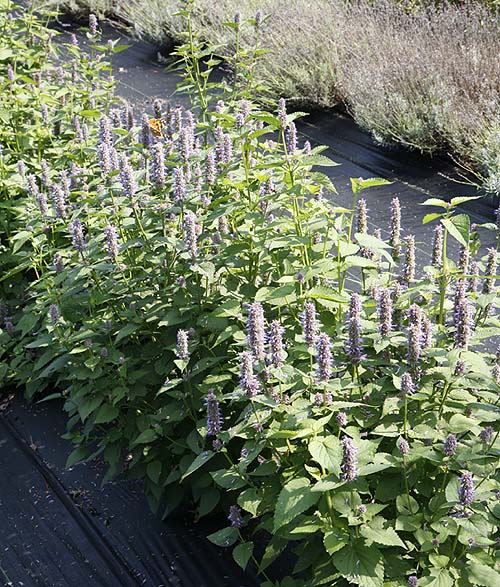A lovely North American native perennial that produces large spikes of blue/violet flowers throughout the summer months. It likes heat and full sun but a tough plant since its native to the prairies and its fairly drought tolerant. Its not particularly fussy about the soil and although many sources claim it likes alkaline soils it seems to do just as well on neutral to slightly acid ones. It does need good drainage though and will not tolerate waterlogged soils. Hardy to zone 4 it's a tough plant that dies back to the ground every winter and comes back year after year to provide a lovely anise/licorice scent from both the leaves and the flowers. Without watering it will grow to about 3 feet (91 cm) in height but if watered regularly it can reach 6 feet (183 cm). Due to it's highly aromatic nature the deer don't eat it, there are reports of it being a favorite of rabbits however we have not had any eat ours. Butterflies and bees and humming birds love the flowers and will flock to it. The seeds are loved by goldfinches and they also flock to the plants often making it seem like they are reflowering in bright yellow blooms. Save the seeds and make your own winter birdfood! It's also great in the kitchen and the flowers can be dried to use in flower arrangements, where they also keep the delightful scent. Its great to have around the patio or even in pots on the deck. Every versitle, no garden should be without it.
Plant confusion. Despite its name its not really a hyssop its in the mint family - as can be seen from the square stems. Its also not an anise which is a different plant entirely (Pimpinella anisum). It does however had the scent of anise and flowers that sort of look like hyssop if you squint at it.
Location and care of Anise Hyssop (Agastache foeniculum)
Plants prefer full sun and reasonable water to reach their full potential. In this kind of location they will grow up to 6 feet (183 cm) with tough stems that don't blow over in high winds. This height can take 2-3 years to achieve plants tend to be no more than 3 feet (91 cm) in the first year. If planted in semi shade plants tend to grow tall and thin stems will bend over and will need staking. Some dappled shade might be tolerated in zones 8 and warmer. Anise Hyssop is not too fussy about soil type and will grow on almost anything provided it is well drained. It does well in poor soils and often will do less well in very rich soils. A little compost is good but for this plant a lot is often too much.
If watered daily - best using a soaker hose - plants will grow tall, if left alone they will grow to about 3 feet and still bloom well. I have had plants growing on a mounded pile of soil that was left over from a field project and discarded pots that were never watered. It's a tough plant once established and needs little care. Cutting down the stalks in early spring before the new growth arises is really the only time it takes. If grown in a stand alone bed this can easily be done using a lawn mower or strimmer.
Some sites report that the plant is hard to move once established due to tap roots. We have not found this and have often dug up plants moved them or donated them to our local butterfly house (butterflies love this plant) and had no problems with plants growing well.
The plant has a wondeful aroma which most people love, as to birds, butterflies, humming birds and bees but not rabbits or deer. Some have reported that rabbits eat it, we have not found that to be the case.










